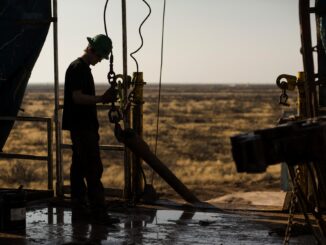
The latest weekly rig count report from Baker Hughes, released on November 14, 2025, shows a modest increase in U.S. drilling activity. The total number of active rigs in the United States rose by one to 549, marking a slight uptick amid ongoing fluctuations in the energy sector.
This comes as the industry navigates volatile oil prices and shifting demand dynamics. While this week’s gain is small, it contrasts with a year-over-year decline of 35 rigs, reflecting broader caution among producers.
U.S. Rig Count Breakdown by Oil and Gas
The increase was driven primarily by oil-directed drilling, with gas rigs seeing a pullback:
Oil Rigs: Up by 3 to 417 (down 61 year-over-year).
Gas Rigs: Down by 3 to 125 (up 24 year-over-year).
Miscellaneous Rigs: Up by 1 to 7.
This shift suggests operators are responding to current market conditions, with oil drilling gaining momentum while natural gas activity softens, possibly due to storage levels and pricing pressures.
Rig Counts by State
Detailed state-level data from the latest report highlights activity in key producing regions. While comprehensive breakdowns aren’t always itemized in summary reports, major states based on basin distributions include:
Texas: Approximately 260 rigs, reflecting its dominance in the Permian and Eagle Ford basins. The state likely saw a net gain this week aligned with Permian’s increase.
New Mexico: Around 100 rigs, concentrated in the Permian Basin, are contributing to the overall uptick.
North Dakota: About 35 rigs, primarily in the Williston Basin (Bakken), with stable or minor changes.
Oklahoma: Roughly 30 rigs, spread across basins like the Anadarko.
Louisiana: Around 30 rigs, focused on Haynesville shale for gas.
Pennsylvania: Approximately 20 rigs, in the Marcellus/Utica for natural gas.
Colorado: About 15 rigs, in the DJ-Niobrara.
Wyoming: Around 15 rigs.
Alaska: 5-10 rigs, mostly offshore or North Slope.
California: Fewer than 5 rigs, with minimal activity.
These estimates are derived from basin trends and historical patterns, as exact weekly state splits aren’t fully detailed in the primary release but align with major basin movements.
Rig Counts by Basin
Basins provide a clearer picture of where activity is heating up or cooling down. The Permian Basin, the epicenter of U.S. oil production, led the gains:Permian Basin: Up by 2 to 253 (down 52 year-over-year). This oil-heavy basin accounts for nearly half of U.S. rigs and saw increases in oil-directed drilling.
Eagle Ford Shale: Down by 1 to 41 (down 7 year-over-year). Primarily oil-focused, with some gas.
Other Key Basins (based on recent trends and no major changes reported this week):
Williston Basin (Bakken): Stable at around 35 rigs, mostly oil.
Haynesville Shale: Around 40 rigs, gas-dominated, potentially impacted by the gas rig decline.
DJ-Niobrara: Approximately 15 rigs, mixed oil and gas.
Marcellus/Utica: Around 30 rigs, primarily gas.
Anadarko Basin: Roughly 20 rigs, mixed.
The Permian’s growth underscores its role as a high-productivity area, where technological efficiencies allow for profitable drilling even at moderate oil prices.
International Rig Count Breakdown by Oil and Gas by Country
Internationally, Baker Hughes reports rig counts on a monthly basis, with the latest data for October 2025 showing a decline in activity.
The total international rig count (excluding the U.S. and Canada) fell by 25 to 1,059, down 101 year-over-year. This represents a broader slowdown in global drilling.
While full country-level breakouts by oil and gas aren’t itemized in the summary, the data is aggregated by region with a focus on combined oil and gas rigs. Globally, oil rigs totaled 1,800, down 12 month-over-month and 164 year-over-year, indicating that oil-directed activity dominates international counts. Key regional insights include:
Middle East: 505 rigs (down 6 month-over-month, down 47 year-over-year). This region is heavily oil-focused, with major contributors like Saudi Arabia (typically 70-80 rigs, mostly oil), UAE (50-60, oil), Kuwait (30-40, oil), and Iraq (40-50, oil).
Other Regions (aggregated totals based on trends, as specific October splits aren’t detailed):
Latin America: Around 180 rigs, mixed oil and gas; countries like Argentina (60, gas-heavy Vaca Muerta), Brazil (20-30, offshore oil), Mexico (40, oil).
Asia Pacific: Approximately 200 rigs, oil and gas; India (100+, mixed), Indonesia (30, oil/gas), Australia (20, gas).
Africa: About 100 rigs, mostly oil; Algeria (30, oil/gas), Nigeria (20, oil), Egypt (30, gas/oil).
Europe: Around 70 rigs, gas and oil; Norway (20, offshore oil), UK (10, oil/gas).
The lack of granular per-country oil/gas splits in the report highlights that international activity is predominantly oil-oriented, with gas playing a secondary role in regions like Asia and Latin America.
What This Means for Investors
For investors in the energy sector, this week’s U.S. rig count increase signals a tentative rebound in drilling sentiment, particularly for oil in the prolific Permian Basin. The uptick in oil rigs could foreshadow higher crude production in 3-6 months, potentially supporting stocks of exploration and production (E&P) companies like those in the Permian (e.g., Occidental Petroleum, ConocoPhillips) and service providers (e.g., Baker Hughes, Halliburton). However, the year-over-year drop and gas rig decline suggest ongoing restraint, driven by factors like ample inventories and uncertain demand from economic slowdowns.
Internationally, the monthly decline points to reduced capital spending abroad, possibly due to OPEC+ production cuts, geopolitical tensions, or lower prices.
This could tighten global supply over time, benefiting U.S. exporters and boosting prices—positive for integrated majors like ExxonMobil or Chevron with international exposure. Investors should monitor WTI and Brent crude prices (currently hovering around $70-80/bbl), natural gas futures, and upcoming EIA production reports for confirmation. Overall, while the slight U.S. gain is encouraging, the broader downtrend advises a cautious approach, favoring diversified energy portfolios or ETFs like XLE over high-risk pure-play drillers.
Also, consider investing in private operators with tax-preferred benefits. And as always, we do not give investment advice; check with your CPA or CFP, and now is the time to make sure you are covered for taxes in 2025.








Be the first to comment